News
Are You Part of the 43% Hooked? Smartphone Addiction Statistics Highlight the Spread of Nomophobia
Here's the latest smartphone addiction stats in 2025
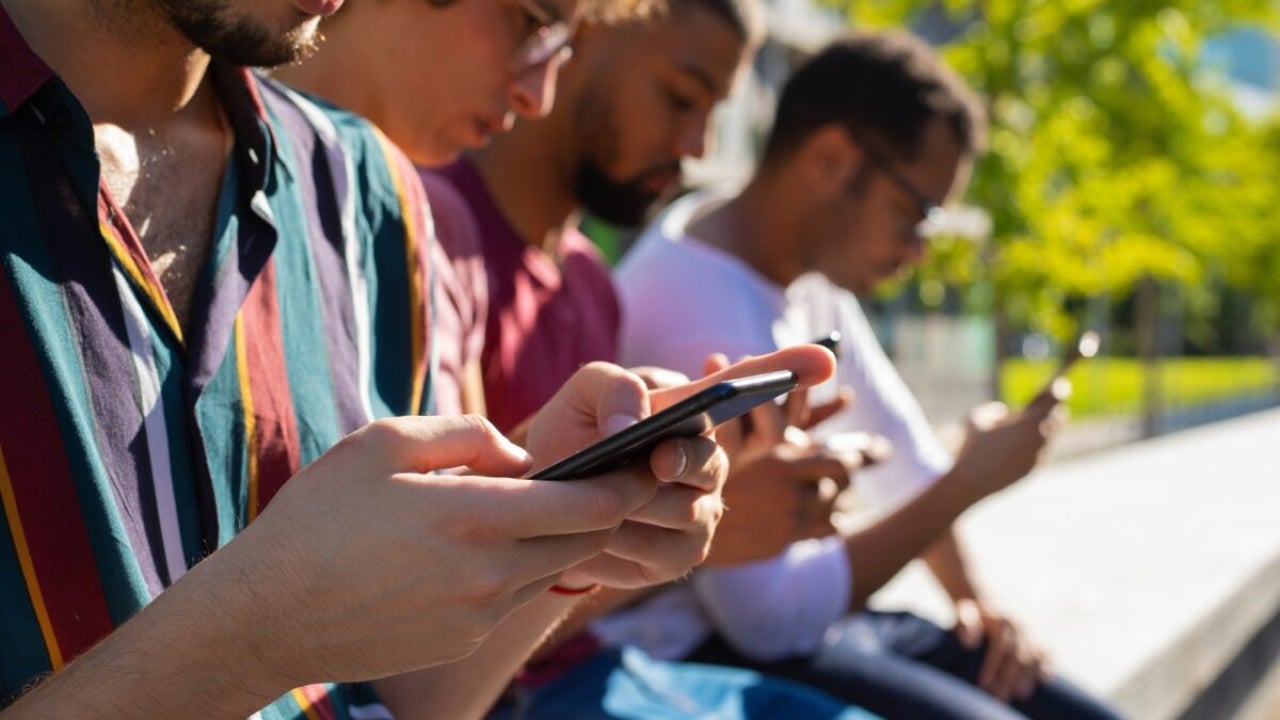
- February 7, 2025
- Updated: February 11, 2025 at 2:40 AM
Smartphone addiction… Does that sound familiar? If you’re checking your phone every five minutes and feel your heart skip a beat every time you forget your trusty iPhone home, you might be one of the many billions of smartphone addicts in the world. And you’re definitely not to blame.
We currently rely on our phones not just for communicating and connecting with our family and friends, but also to make all kinds of transactions as well as a never ending source of entertainment. But… How bad is smartphone addiction?
While being addicted to our phones isn’t generally seen as a bad thing, it definitely can have devastating (and even deadly) effects on our mind and body. Here’s what we can learn from smartphone addiction through its latest stats and trends in 2025.
Top Smartphone Addiction Stats (2025)
- 43.2% of Americans admitted they are addicted to their smartphones.
- 56% of Gen Zs and 48% of Millennials in the US suffer from smartphone addiction.
- The average American checks their smartphone 205 times per day.
- Globally the average person checks their smartphone 58 times per day.
- 81% of US adults admitted that they check their smartphone within the first 10 minutes after waking up.
- 44% of American adults suffer nomophobia (fear and anxiety cause by not having their smartphone) while 39.6% feel similar symptoms when their battery goes below 20%
- 48.3% of Americans claim they have never gone without their smartphone for over 24 hours.
- 67% of teenagers reported that late-night phone use has caused them to lose sleep.
- Cellphones cause 20% of car accidents.
How Many Smarphone Addicts Are There Worldwide?
There are over 6.8 billion smartphone users in the world, and among them, 6.3% admitted to suffer from a phone addiction. The evolution of smartphones and its apps are the main reasons for phone addictions, with messaging apps being the most likely culprit. Supporting this data we find a recent study made by Virgin Mobile, in which it is stated that currently, smartphone users receive 427% more messages and send 278% more texts than a decade ago.
Which Country Has the Most Mobile Addiction?
According to Data Reportal’s Digital 2024 report, Indonesia is the country with the highest smartphone addiction. The data gathered shows how the average Indonesian spends 6 hours and 3 minutes using their phones on a daily basis. The numbers are followed closely by the Philippines, with an average daily time of 5 hours and 54 mins spent using mobile phones. Closing the top 3 we find Thailand, with an average smartphone usage time of 5 hours and 38 minutes per day.
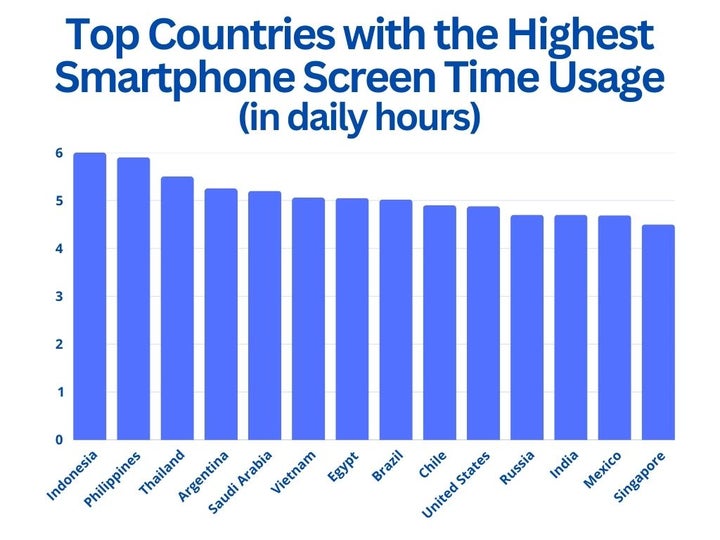
Here’s a detailed breakdown of the results:
- Indonesia: 6 hours 03 minutes.
- Philippines: 5 hours 54 minutes.
- Thailand: 5 hours 38 minutes.
- Argentina: 5 hours 21 minutes.
- Saudi Arabia: 5 hours 16 minutes.
- Vietnam: 5 hours 15 minutes.
- Malaysia: 5 hours 06 minutes.
- Egypt: 5 hours 05 minutes.
- Brazil: 5 hours 02 minutes.
- Chile: 4 hours 59 minutes.
- US: 4 hours 54 minutes.
- Russia: 4 hours 47 minutes.
- India: 4 hours 46 minutes.
- Mexico: 4 hores 43 minutes.
- Singapore: 4 hours 31 minutes.
43% of Americans Are Addicted to their Smartphones
A recent report made by PewResearch shows how 98% of Americans own a cell phone of some kind and among those, 91% is a smartphone. But, how many of those are addicted to their phone? According to Reviews.org, as of January 2025, over 43% of Americans admit feeling addicted to their smartphones. While this number is very high, it’s important to point out how cell-phone addiction is down 24% compared to last year’s results.
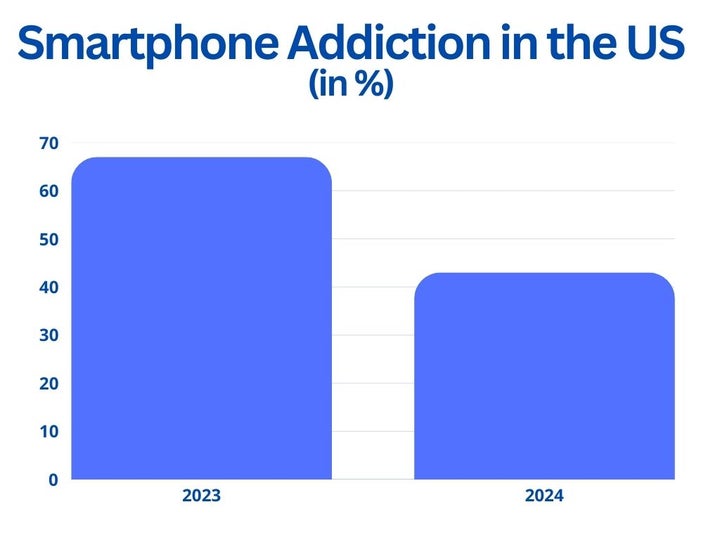
But that’s not all, 51.3% of Americans admitted to sleeping with their phone at night. This breaks with their sleep patterns and is closely related to the fact that 69% of smartphone addicts have a poor sleep quality. In fact, phone addiction is so high in the US that 65.7% of Americans reported that they use their phone on the toilet and inhibits communication to the point that 53.7% stated that they used their smartphone to text someone in the same room.
How Often do People Check Their Phones in a Day?
While the numbers might surprise you, the average American checks their phone 205 times a day (VS the global average of 150 times per day). If we look at the big numbers, that’s once every five minutes during the waking hours. The numbers are backed up by the fact 76% of the users check their phones within 5 minutes of receiving a notification.
It’s also relevant that, while smartphones leave us while we sleep, they quickly come back to our lives when we wake up. This has been proven by the fact that 81% of Americans check their phones within 10 minutes of waking up.

Almost Half of Americans Can’t Go Longer than 24 Hours Without their Phone
Smartphone dependency is dangerously high in the US, with 43.2% of Americans considering themselves addicted to their phones and 48.3 admitting to have never gone longer than 24 hours without them.
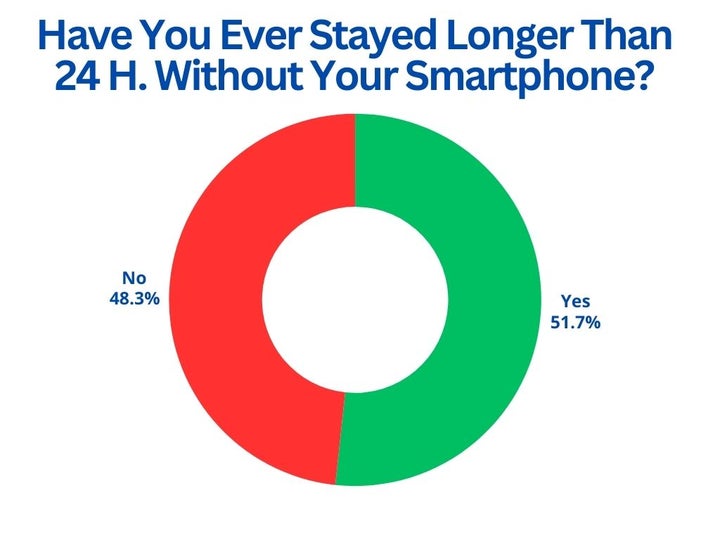
This fear of being without a mobile phone has a name, nomophobia (no mobile phobia) and can cause psychological harm. This can be seen through data, with 78.20% of US citizens stating they feel uneasy when leaving their phone at home and 39.60% admitting they feel a sense of panic or anxiety when their phone battery goes below 20%.
Smartphone Addiction by Age
Age plays a significant role in smartphone addiction. Recent studies found out that teenagers aged 13-17 have the highest rate of smartphone addiction, with 50% of them suffering the effects of nomophobia. Young adults aged 18-29 come in second position, with 21% of them admitting their smartphone addiction. In third place we find adults over 65, with 17% of them reporting their phone dependency. Closing the list we find people aged 50-64 and 30-49, with 14% and 11% respectively.
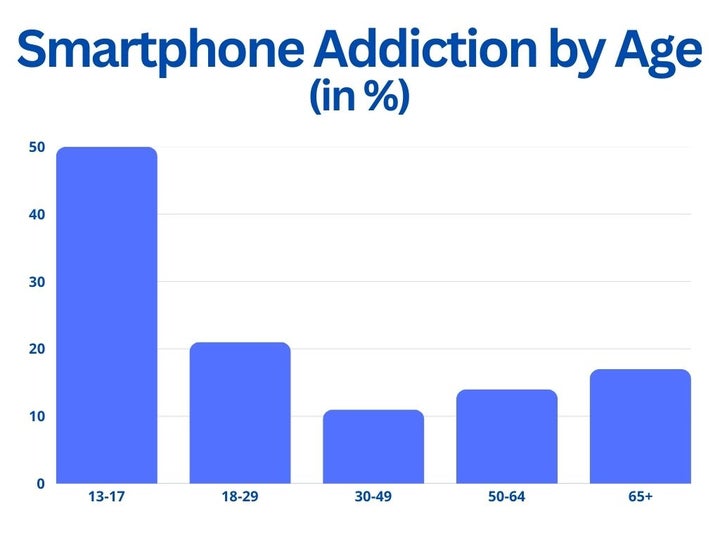
Here’s a breakdown of the results:
- 13-17: 50%
- 18-29: 21%
- 30-49: 11%
- 50-64: 14%
- 65+: 17%
(Source: PewReseach)
Smartphone Addiction by Generation
A different study made in the United States shows that 56% of Generation Z respondents are addicted to their phones. Millennials come close in second position, with almost half of the respondents belonging to that generation. Gen X and Baby Boomers are the generation that are less likely to be addicted to smartphones, with only 44% and 29% of the surveyed developing an addiction.
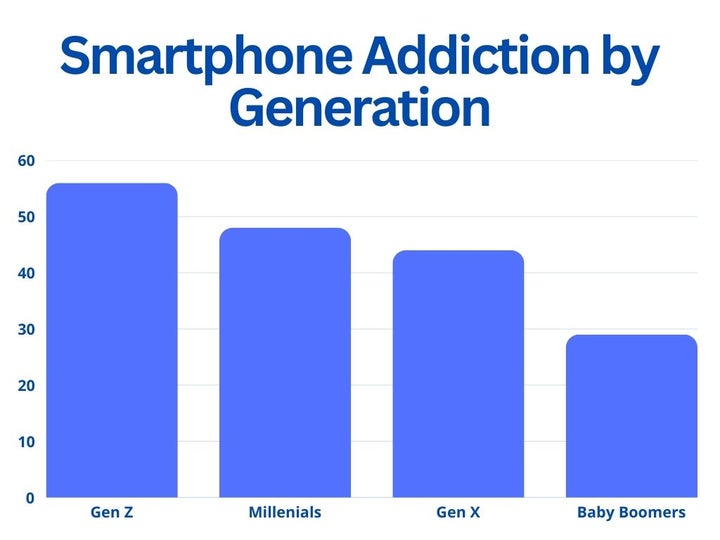
Here’s what complete survey data:
- Gen Z: 56%
- Millennials: 48%
- Gen X: 44%
- Baby Boomers: 29%
(Source: Statista)
Smartphone Addiction by Gender
According to the NIH, there’s no real correlation between gender and smartphone addiction. While men (54%) are more likely to be addicted to their mobile device, the difference with women (46%) is so small that is almost dismissible.
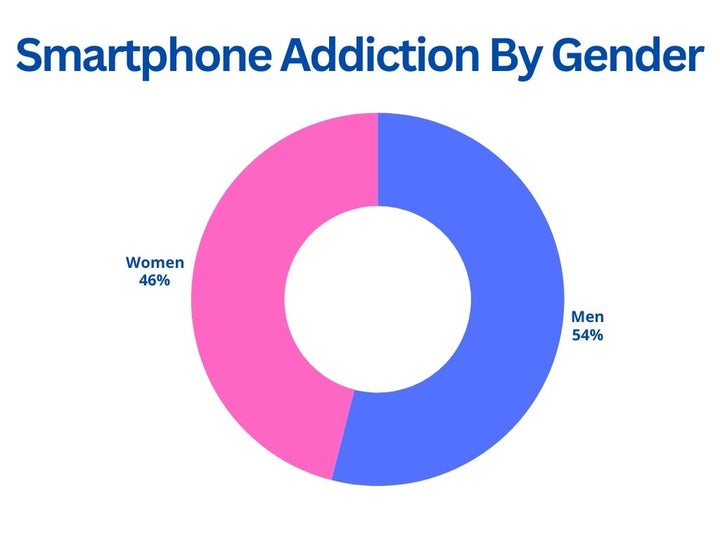
Impact of Smartphone Addiction on Teenagers Health
As shown in the results above, teenagers are the age group with the highest rate of smartphone addiction, and its consequences can be detrimental to their health. According to the data gathered by Bankmycell, teenagers that spend 5 hours a day on smartphones are 71% more likely to have suicide factors than those with just 1 hour of use. Also, teens that spend 5 or more hours on phones are 51% more likely to get under 7 hours of sleep per day.
If we look at the impacts on their academic life, 67% of teachers have observed that students are negatively distracted by smartphones during their teaching hours. But that’s not everything, smartphone addiction is also clearly linked to mental health handicaps. This is corroborated by the same survey, where 90% of teachers stated that the number of students with emotional challenges increased due smartphone usage.
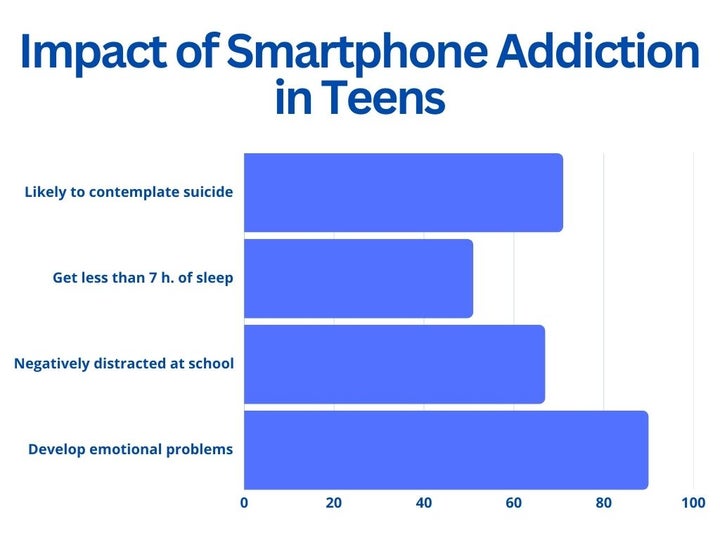
Impact of Smartphone Addiction on Adults
While teens are more likely to suffer the effects of smartphone addiction, they aren’t the only ones. As reported by YouGov, 42% of American adults admit to wasting too much time with their smartphones. This has effects in their workplace, with 30% stating they would be more productive if they didn’t bring their smartphones to work. Smartphone addiction also has crushing effects in relationships, with 71% of people spending more time on their phone than their romantic partner.
As shown by a study made by Ariel University, subjects with smartphone addictions are bound to suffer mental health disorders such as depression, anxiety, OCD, ADHD as well as alcohol consumption. There’s also a darker and deadlier side to smartphone addiction, with cell phones causing 1 in every 5 accidents due checking the smartphone or texting while driving.
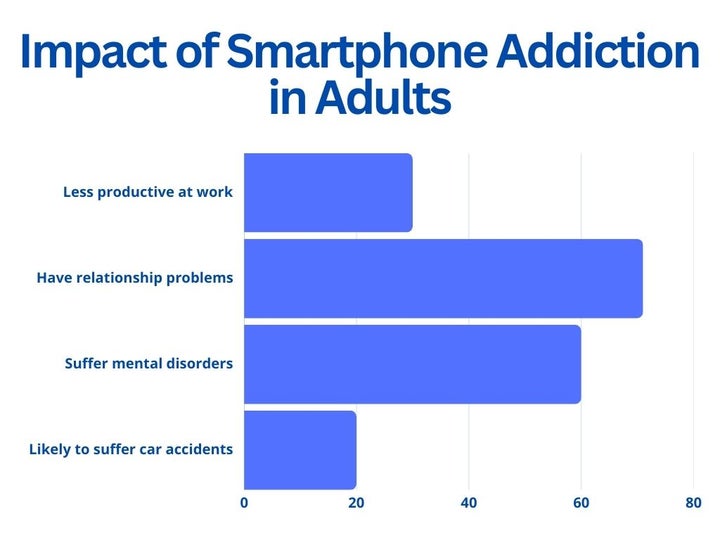
Conclusion
While smartphones are very helpful devices and a great way to stay connected to the world around us, they can also be dangerous. As seen by the data above, excessive time spent on our smartphones puts our work, personal life and mental health in danger. With over 60% of the global population owning a smartphone, and the numbers growing, it is undeniable that mobile phones are here to stay. And that doesn’t make them less addictive. That being said, it is our responsibility to balance smart phone usage with our personal life.
Mireia Fernández is passionate about the world of video games and new technologies, a hobby that dates back to her childhood with the MSX HB 501p. Born and residing in Barcelona, Mireia has been working as an editor for over 10 years and specializes in writing reviews, tutorials, and software guides, as well as doing everything possible to publish news before anyone else. Her hobbies include spending hours playing on her console, walking her golden retriever, and keeping up with the latest SEO developments.
Latest from Mireia Fernández
You may also like

From ethics to war: the shift in Google's approach to AI development
Read more

Elon Musk rules out acquiring TikTok amid legal pressures
Read more

Tom Cruise is back in a new and crazy trailer for his crazier character
Read more

Can a video game help investigate safety while driving? Apparently, yes
Read more

Valve explicitly prohibits advertising within video games on its platform
Read more

If you like Dragon Age, a former BioWare producer reveals that you should play this Sonic game
Read more